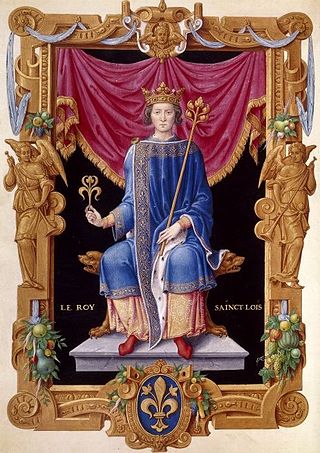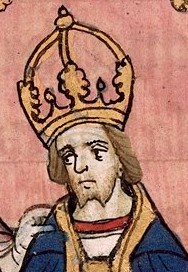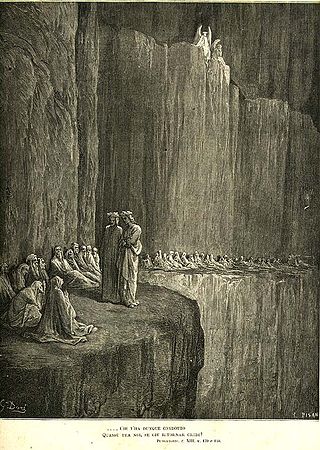
Year 1269 (MCCLXIX) was a common year starting on Tuesday of the Julian calendar.

The Republic of Florence, known officially as the Florentine Republic, was a medieval and early modern state that was centered on the Italian city of Florence in Tuscany, Italy. The republic originated in 1115, when the Florentine people rebelled against the Margraviate of Tuscany upon the death of Matilda of Tuscany, who controlled vast territories that included Florence. The Florentines formed a commune in her successors' place. The republic was ruled by a council known as the Signoria of Florence. The signoria was chosen by the gonfaloniere, who was elected every two months by Florentine guild members.

Arnolfo di Cambio was an Italian architect and sculptor of the Duecento, who began as a lead assistant to Nicola Pisano. He is documented as being capomaestro or Head of Works for Florence Cathedral in 1300, and designed the sixth city wall around Florence (1284–1333).

The Guelphs and Ghibellines were factions supporting respectively the Pope and the Holy Roman Emperor in the Italian city-states of Central Italy and Northern Italy during the Middle Ages. During the 12th and 13th centuries, rivalry between these two parties dominated political life across medieval Italy. The struggle for power between the Papacy and the Holy Roman Empire arose with the Investiture Controversy, which began in 1075 and ended with the Concordat of Worms in 1122.

Colle di Val d'Elsa or Colle Val d'Elsa is a town and comune in the province of Siena, Tuscany. It has a population of c. 21,600 As of June 2017. Its name means "Hill of Elsa Valley", where Elsa is the name of the river which crosses it and Valdelsa the name of the valley. In the 21st century, Colle di Val d'Elsa is internationally renowned for the production of crystal glassware and art, largely produced in the industrial lower town.

The Battle of Campaldino was fought between the Guelphs and Ghibellines on 11 June 1289. Mixed bands of pro-papal Guelf forces of Florence and allies, Pistoia, Lucca, Siena, and Prato, all loosely commanded by the paid condottiero Amerigo di Narbona with his own professional following, met a Ghibelline force from Arezzo including the perhaps reluctant bishop, Guglielmino degli Ubertini, in the plain of Campaldino, which leads from Pratovecchio to Poppi, part of the Tuscan countryside along the upper Arno called the Casentino. One of the combatants on the Guelph side was Dante Alighieri, twenty-four years old at the time.

The Battle of Montaperti was fought on 4 September 1260 between Florence and Siena in Tuscany as part of the conflict between the Guelphs and Ghibellines. The Florentines were routed. It was the bloodiest battle fought in Medieval Italy, with more than 10,000 fatalities. An act of treachery during the battle is recorded by Dante Alighieri in the Inferno section of the Divine Comedy.

Castelfiorentino is a city and comune (municipality) in the Metropolitan City of Florence, Tuscany, central-northern Italy, located between Florence, Pisa (45 km) and Siena (55 km). The population numbers approximately 20,000 inhabitants. It is part of Valdelsa. Castelfiorentino borders the following municipalities: Certaldo, Empoli, Gambassi Terme, Montaione, Montespertoli and San Miniato.
Giordano d'Agliano, sometimes Giordano Lancia, was an Italian nobleman and military commander who served as marshal of the Kingdom of Sicily under King Manfred (1258–1266). He played a prominent role in the wars of the Guelphs and Ghibellines in Tuscany.

Scrofiano is a village in Tuscany, central Italy, a frazione of the comune of Sinalunga in the province of Siena. It is located on a hill in Val di Chiana, a few kilometers from Sinalunga proper.
Associazione Sportiva Dilettantistica Olimpia Colligiana is an Italian association football club based in Colle di Val d'Elsa, Tuscany that competes in Eccellenza Tuscany.
Napoleone della Torre, also known as Napo della Torre or Napo Torriani, was an Italian nobleman, who was effective Lord of Milan in the late 13th century. He was a member of the della Torre family, the father of Corrado della Torre and the brother of Raimondo della Torre.
An incomplete list of events in 1289 in Italy:

Henry VII, also known as Henry of Luxembourg, was Count of Luxembourg, King of Germany from 1308 and Holy Roman Emperor from 1312. He was the first emperor of the House of Luxembourg. During his brief career he reinvigorated the imperial cause in Italy, which was racked with the partisan struggles between the divided Guelph and Ghibelline factions, and inspired the praise of Dino Compagni and Dante Alighieri. He was the first emperor since the death of Frederick II in 1250, ending the Great Interregnum of the Holy Roman Empire; however, his premature death threatened to undo his life's work. His son, John of Bohemia, failed to be elected as his successor, and there was briefly another anti-king, Frederick the Fair, contesting the rule of Louis IV.
The Battle of Pieve al Toppo was fought between Arezzo and Siena. The two sides engaged in the battle, and Arezzo was able to take the town. Later on in history, Florence would take over the town, and Arezzo was forced to retake it all over again.

The Diocese of Colle di Val d’Elsa was a Roman Catholic diocese located in the town of Colle di Val d'Elsa in Tuscany, Italy, in the province of Siena. The diocese was established by Pope Clement VIII on 5 June 1592, in the bull "Cum Super Universas", with territory taken from the Archdiocese of Florence, the Archdiocese of Siena, the Diocese of Fiesole, and the Diocese of Volterra. The new diocese was made a suffragan of the metropolitanate of Florence. On 18 September 1782 the diocese gained additional territory from Diocese of Volterra. In 1986, it was suppressed.

The Republic of Siena in its progressive territorial growth saw its borders expanding especially in the territories of southern Tuscany in the current province of Grosseto. The possession of an "access to the sea" by Siena was therefore a natural continuation of its expansionary and commercial policy in the Maremma with the conquest of the ports of Talamone, Porto Ercole and Porto Santo Stefano.

The Republic of Massa was a small Italian state located in Central Italy that existed from 1225 to 1336. It was founded in today's city of Massa Marittima and expanded to cover an area corresponding to the current upper Maremma.

Guido Guerra V (1220-1272) was a politician from Florence, Italy. Aligned with the Guelph faction, Guerra had a prominent role in the political conflicts of mid-thirteenth century Tuscany. He was admired by Dante Alighieri, who granted him honor in the Divine Comedy, even though he placed Guerra in Hell among sinners of sodomy.

Sapia Salvani was a Sienese noblewoman. In Dante Alighieri's Divine Comedy, she is placed among the envious souls of Purgatory for having rejoiced when her fellow Sienese townspeople, led by her nephew Provenzano Salvani, lost to the Florentine Guelphs at the Battle of Colle Val d'Elsa.















